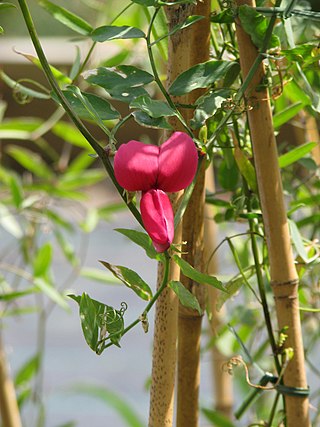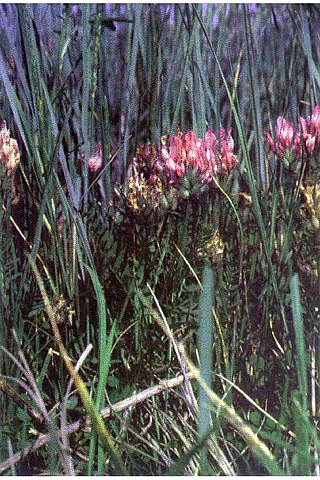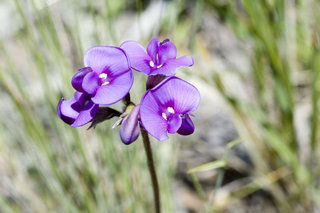
Lathyrus is a genus of flowering plants in the legume family Fabaceae, and contains approximately 160 species. Commonly known as peavines or vetchlings, they are native to temperate areas, with a breakdown of 52 species in Europe, 30 species in North America, 78 in Asia, 24 in tropical East Africa, and 24 in temperate South America. There are annual and perennial species which may be climbing or bushy. This genus has numerous sections, including Orobus, which was once a separate genus. The genus has numerous synonyms, including Pisum, the ancient Latin name for the pea.

Lathyrus latifolius, the perennial peavine, perennial pea, broad-leaved everlasting-pea, or just everlasting pea, is a robust, sprawling herbaceous perennial flowering plant in the pea family Fabaceae. It is native to Europe but is present on other continents, such as North America and Australia, where it is most often seen along roadsides.

Lathyrus japonicus, the sea pea, beach pea, circumpolar pea or sea vetchling, is a species of flowering plant in the legume family Fabaceae, native to temperate coastal areas of the Northern Hemisphere, and Argentina.
Beach pea is a common name for several plants and may refer to:
Dalea mollis is a species of flowering plant in the legume family which is known by the common name hairy prairie clover.

Dalea mollissima is a desert wildflower plant in the legume family (Fabaceae), with the common names soft prairie clover, downy dalea, and silk dalea.

Erysimum menziesii is a species of Erysimum known by the common name Menzies' wallflower.

Lathyrus delnorticus is an uncommon species of wild pea known by the common name Del Norte pea. It is native to the Klamath Mountains of southern Oregon and northern California, where it is a member of the serpentine soils flora. This is a hairless perennial herb producing a winged or flanged stem. The leaves are made up of several pairs of oval or lance-shaped leaflets and the stipules of the leaves are wide and toothed. There are branching, coiled tendrils. The plant bears a dense inflorescence of up to 10 pea lavender-veined white flowers each up to 1.5 centimeters wide. The fruit is a hairless dehiscent legume pod.

Lathyrus hirsutus is a species of wild pea known by several common names, including Caley pea, singletary pea, hairy vetchling, and Austrian winter pea. It is native to Europe, North Africa, and much of Asia, and it is known from other continents, including North America, as an introduced species. This is an annual herb producing a winged stem and leaves each made up of two leaflike leaflets with a branching, coiled tendril. The inflorescence holds one or two pink, blue, or bicolored pea flowers each 1 to 1.5 centimeters wide. The fruit is a dehiscent legume pod covered in hairs with each hair growing from a minute bulbous base. The rest of the plant is generally hairless.
Lathyrus jepsonii is a species of wild pea known by the common names delta tule pea and Jepson's pea. It is endemic to California, where it grows in a number of habitat types, including forest and estuary.

Lathyrus palustris is a species of wild pea known by the common name marsh pea. It is native to Europe, Asia, and North America. It is a perennial herb with leaves made up of oval-shaped or oblong leaflets a few centimeters long. It has branched, coiled tendrils. The plant bears an inflorescence of two to eight pinkish purple pea flowers each up to two centimeters wide. The fruit is a dehiscent legume pod.

Lathyrus polyphyllus is a species of wild pea known by the common name leafy pea. It is native to the western United States from Washington to northern California, where it grows in forest and other habitat. This is a perennial herb with long leaves each made up of many pairs of oval-shaped leaflets a few centimeters long. The leaf also has tendrils which may be long, branched and coiled, or just a short bristle. The stipules are large as well, often over a centimeter wide. The plant produces an inflorescence of up to 12 pea flowers usually arranged in a line along one side of the stem. The flowers are up to 2 centimeters wide and are a variety of shades of purple. The fruit is a dehiscent legume pod containing peas.

Lathyrus splendens is a species of wild pea known by the common names pride of California and Campo pea. It is native to Baja California and its range extends into San Diego County, California, where it grows in the chaparral. This is a climbing perennial pea vine with coiling tendrils. Its leaves are each made up of 6 to 8 linear to oval-shaped leaflets a few centimeters long and wavy-margined stipules. The plant produces showy inflorescences of up to 6 bright to deep red flowers each about 3 centimeters wide. The fruit is a hairless dehiscent legume pod.

Lathyrus sulphureus is a species of wild pea known by the common names snub pea and sulphur pea.

Astragalus agrestis is a species of milkvetch known by the common names purple milkvetch, purple loco, and field milkvetch. It is native to much of western and northern North America from most of Canada to the southwestern United States, as well as eastern Asia. It grows in vernally moist areas such as meadows, and is often found in sagebrush.

Lathyrus sphaericus is a species of wild pea known by the common names grass pea and round-seeded vetchling. It is native to Eurasia and much of Africa, and it is known on other continents as an introduced species. It can grow in many types of habitat, including disturbed areas. This is an annual herb producing a slender stem and bearing leaves each made up of two long, narrow, grasslike leaflets up to 6 centimeters long and a coiling, climbing tendril. The inflorescence is made up of one pea flower on a stalk one or two centimeters long ending a in a bristle. The flower is roughly a centimeter long and deep orange-red or dull red in color. The fruit is a hairless legume pod marked with longitudinal stripes.

Stellaria littoralis is a species of flowering plant in the family Caryophyllaceae known by the common name beach starwort. It is endemic to the San Francisco Bay Area and North Coast of California, where it grows in moist coast habitat, such as marshes, bogs, and coastal bluffs. It is a rhizomatous perennial herb producing sprawling, branching stems which are four-angled and hairy in texture, reaching up to about 60 centimeters long. The lance-shaped or pointed oval leaves are up to 4.5 centimeters long and are oppositely arranged in pairs. The inflorescence bears several flowers, each on a short pedicel. The flower has five hairy, pointed green sepals each a few millimeters long. There are five white petals, each so deeply lobed it appears to be two.

Potentilla villosa is a species of flowering plant in the rose family, Rosaceae. Its common names include villous cinquefoil, northern cinquefoil, and hairy cinquefoil. It is native to northwestern North America, where its distribution extends from Alaska to Alberta to Oregon. There are records from eastern Asia.

Swainsona sericea commonly known as silky Swainson-pea or silky pea, is a flowering plant in the family Fabaceae. It is a small perennial with greyish-green leaves, purple flowers and grows in New South Wales, Victoria and South Australia.
















